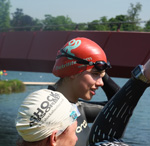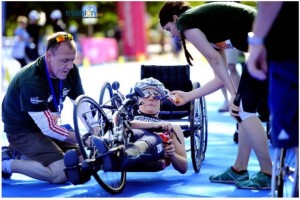-
About Para Tri and How To Get Involved
- Posted onjofrancis
- in Uncategorized
- onAugust 28, 2014
- No Comments.
 By Ashleigh Ahlquist
By Ashleigh AhlquistTriathlon is a steadily growing sport as we all know…. and that includes Paratriathlon. Paratri is becoming ever popular following on from our successes at the Paralympics, media coverage and an increase in money entering the sport. The sport is governed by the International Triathlon Union and will, for the first time, be held as an event at the 2016 Paralympics in Rio.
What is Paratriathlon?
It can be really confusing as there are different categories and ways of taking part in the sport. There are five main categories to compete in over the sprint distance of 750m swim, 20km bike (hand bike/tandem) and 5km run (racing wheelchair). A detailed description of the categories can be found here.
 As a coach, I have supported quite a number of PT1 athletes who use a recumbent handcycle on the bike course and a racing wheelchair on the run segment. These athletes are allowed two handlers to help them in both transitions. Here’s a photo of me and John supporting Karen Darke in the London Triathlon this year. We had just lifted her out of her day chair into her handcycle for the bike section, John was helping her with her waist strap and I’m passing her a gel for some mid race fuel.
As a coach, I have supported quite a number of PT1 athletes who use a recumbent handcycle on the bike course and a racing wheelchair on the run segment. These athletes are allowed two handlers to help them in both transitions. Here’s a photo of me and John supporting Karen Darke in the London Triathlon this year. We had just lifted her out of her day chair into her handcycle for the bike section, John was helping her with her waist strap and I’m passing her a gel for some mid race fuel.If you are thinking about or would like to take part in Paratri at a National/International level then it’s really important that you get classified as soon as you can so you know which category you best suit. Take a look here for guidance and tips.
How can I get involved?
There are loads of great ways to get involved as an athlete and as a supporter. Leonard Cheshire run some great Paratriathlon friendly events in London and Glasgow and also offer a number of different volunteering opportunities. Have a look on their website for more details. British Triathlon run Talent ID days and open days to help you learn more about the sport and give athletes the opportunity to show off their strengths and Olympic potential.
The PT5 category is for athletes with a Total or Partial visual impairment. These athletes have a guide who has to be from the same nationality and be the same gender. They compete all three sections, tethered on the swim and run and at the front of a tandem during the bike segment. PT5 athletes are always looking for guides and there are many people with visual impairments that need support with exercising. If you are interested, contact the Royal London Society for Blind People or a similar organisation in your area, or put an advertisement out at your local running/triathlon club. The RLSB are running a blindfold run at the Queen Elizabeth Park in November in London which is a great opportunity to experience using a tether to race with, increase awareness and raise money for the organisation. There also a number of social media groups that provide a great place to learn more and ask any questions you may have about the sport. An example is the group ‘Paratriathlon’ on Facebook.
Paratriathlon, as mentioned, is a growing sport which, even more importantly, has many growing athletes within. It shows that no matter what, a sport is always a sport and can be enjoyed by anyone with a competitive streak, regardless of limitation, including those competing in the future Olympic Games. The question is…will we see you there?
If you enjoyed this article please consider sharing it!




